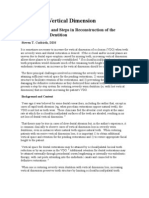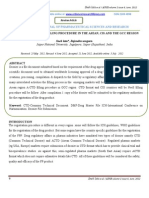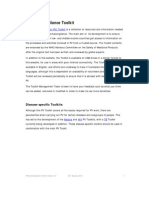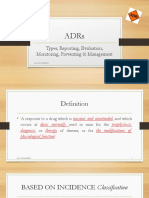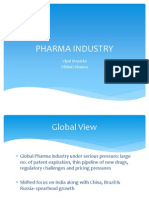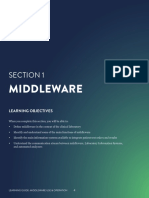0 ratings0% found this document useful (0 votes)
32 viewsDevelopment of New Drugs: Dosen Pengampu: Novia Sinata, M.Si, Apt
Development of New Drugs: Dosen Pengampu: Novia Sinata, M.Si, Apt
Uploaded by
nurul latifahThis document discusses the process for developing new drugs which includes several steps:
1) Discovery and testing of potential new drug molecules in vitro and in animal models to characterize effects, metabolism, and safety.
2) Repeated preclinical safety and toxicity testing in animals over 2-6 years before human trials.
3) Clinical trials in three phases with human subjects to test safety and efficacy before the drug can be approved. Rigorous guidelines and oversight are required due to risks.
The development process aims to thoroughly evaluate risks but has limitations in predicting all effects due to variability between species and individuals. Most drug candidates fail and extensive testing is needed to bring successful new treatments to patients.
Copyright:
© All Rights Reserved
Available Formats
Download as PPTX, PDF, TXT or read online from Scribd
Development of New Drugs: Dosen Pengampu: Novia Sinata, M.Si, Apt
Development of New Drugs: Dosen Pengampu: Novia Sinata, M.Si, Apt
Uploaded by
nurul latifah0 ratings0% found this document useful (0 votes)
32 views29 pagesThis document discusses the process for developing new drugs which includes several steps:
1) Discovery and testing of potential new drug molecules in vitro and in animal models to characterize effects, metabolism, and safety.
2) Repeated preclinical safety and toxicity testing in animals over 2-6 years before human trials.
3) Clinical trials in three phases with human subjects to test safety and efficacy before the drug can be approved. Rigorous guidelines and oversight are required due to risks.
The development process aims to thoroughly evaluate risks but has limitations in predicting all effects due to variability between species and individuals. Most drug candidates fail and extensive testing is needed to bring successful new treatments to patients.
Original Title
DEVELOPMENT OF NEW DRUGS-1.pptx
Copyright
© © All Rights Reserved
Available Formats
PPTX, PDF, TXT or read online from Scribd
Share this document
Did you find this document useful?
Is this content inappropriate?
This document discusses the process for developing new drugs which includes several steps:
1) Discovery and testing of potential new drug molecules in vitro and in animal models to characterize effects, metabolism, and safety.
2) Repeated preclinical safety and toxicity testing in animals over 2-6 years before human trials.
3) Clinical trials in three phases with human subjects to test safety and efficacy before the drug can be approved. Rigorous guidelines and oversight are required due to risks.
The development process aims to thoroughly evaluate risks but has limitations in predicting all effects due to variability between species and individuals. Most drug candidates fail and extensive testing is needed to bring successful new treatments to patients.
Copyright:
© All Rights Reserved
Available Formats
Download as PPTX, PDF, TXT or read online from Scribd
Download as pptx, pdf, or txt
0 ratings0% found this document useful (0 votes)
32 views29 pagesDevelopment of New Drugs: Dosen Pengampu: Novia Sinata, M.Si, Apt
Development of New Drugs: Dosen Pengampu: Novia Sinata, M.Si, Apt
Uploaded by
nurul latifahThis document discusses the process for developing new drugs which includes several steps:
1) Discovery and testing of potential new drug molecules in vitro and in animal models to characterize effects, metabolism, and safety.
2) Repeated preclinical safety and toxicity testing in animals over 2-6 years before human trials.
3) Clinical trials in three phases with human subjects to test safety and efficacy before the drug can be approved. Rigorous guidelines and oversight are required due to risks.
The development process aims to thoroughly evaluate risks but has limitations in predicting all effects due to variability between species and individuals. Most drug candidates fail and extensive testing is needed to bring successful new treatments to patients.
Copyright:
© All Rights Reserved
Available Formats
Download as PPTX, PDF, TXT or read online from Scribd
Download as pptx, pdf, or txt
You are on page 1of 29
DEVELOPMENT OF NEW DRUGS
Dosen Pengampu : Novia Sinata, M.Si, Apt
Kelompok 3
1. Fazri perdana (1501071)
2. Ira Fazira (1801056
3. Nurul Latifah (1801064)
4. Putri Zahra (1801066)
5. Syalshabillah (1801074)
SEKOLAH TINGGI ILMU FARMASI RIAU
DEVELOPMENT OF NEW
DRUGS
New drugs have revolutionized the practice of
medicine, converting many once fatal or
debilitating diseases into manageable therapeutic
exercises.
Among the first steps in the development of
a new drug is the discovery of synthesis of a
potensial new drug molecule and seeking and
understanding of its interaction (mechanism)
with the appropriate biologic target. Repeated
application of this approach leads to compounds
with increased potency and selectivity (figure 5-
1).
By law, the safety and efficacy of drug must
be defined before marketing. In addition to in
vitro studies, relevant biologic effects, drug
metabolism, and pharmacokinetic profiles and
particulary and assessment of the relative safety
of the drug must be characterized in animals
before human drug trial can be started.
With regulatory approval, human testing
can then go forward in three phases before the drug
can be considered for approval for general use. A
fourth phase of data gathering and safety
monitoring is becoming increasingly important and
follows after approval for general use.
DRUG DISCOVERY
Most new drugs or drug products are discovered
or developed through one or more of six
approaches:
1. Identification or elucidation of a
new drug target
2. Rational drug design of a new drug based
on an understanding of biologic mechanisms,
drug receptor structure, and drug structure
3. Chemical modification of a known
molecule
4. Screening for biologic activity of large
numbers of natural products, banks of
previously discovered chemical entities, and
large libraries of peptides, nucleic acids, and
other organic molecules
5.Biotechnology and cloning using genes to
produce peptides and proteins. Efforts
continue to focus on the discovery of new
targets and approaches, from studies with
genomics, proteomics, nucleic acids and
molecular pharmacology for drug therapy.
Significantly increasing the number of
useful disease targets should be a positive
driver for new and improved drugs.
6. Combinations of known drugs to
obtain additive or synergistic effects
or a repositioning of a known drug for
a new therapeutic use.
DRUG SCREENING
Regardless of the source or the key idea
leading to a drug candidate molecule, testing it
involves a sequence of iterative experimentation
and characterization called drug screening. A
variety of biologic assays at the molecular,
cellular, organ system, and whole animal levels
are used to define the activity and selectivity of
the drug (Table 5–1).
The type and number of initial screening
tests depend on the pharmacologic and
therapeutic goal. Anti-infective drugs may be
tested against a variety of infectious organisms
some of which are resistant to standard agents,
hypoglycemic drugs for their ability to lower
blood sugar, etc. In addition, the molecule will
also be studied for a broad array of other actions
to establish the mechanism of action and
selectivity of the drug. This has the advantage of
demonstrating both suspected and unsuspected
toxic effects.
Occasionally, an unsuspected therapeutic
action is serendipitously discovered by the careful
observer. The selection of molecules for further
study is most efficiently conducted in animal
models of human disease. Where good predictive
preclinical models exist (eg, antibacterials,
hypertension or thrombotic disease), we generally
have adequate drugs. Good drugs or breakthough
improvements are conspicuously lacking and
slow for diseases for which pre-clinical models
are poor, or not yet available, eg, Alzheimer's
disease.
PRECLINICAL SAFETY & TOXICITY
TESTING
All drugs are toxic at some dose . Seeking to
correctly define the limiting toxicities of drugs
and the therapeutic index comparing benefits
and risks of a new drug might be argued as the
most essential part of the new drug development
process. Most drug candidates fail to reach the
market, but the art of drug discovery and
development is the effective assessment and
management of risk and not total risk avoidance.
Candidate drugs that survive the initial
screening and profiling procedures must be
carefully evaluated for potential risks before and
during clinical testing. Although no chemical can
be certified as completely "safe" (free of risk), the
objective is to estimate the risk associated with
exposure to the drug candidate and to consider
this in the context of therapeutic needs and
duration of likely drug use.
IT IS IMPORTANT TO RECOGNIZE THE
LIMITATIONS OF PRECLINICAL TESTING.
THESE INCLUDE THE FOLLOWING:
1. Toxicity testing is time-consuming and
expensive. Two to 6 years may be required to
collect and analyze data on toxicity and estimates
of therapeutic index (a comparison of the amount
that causes the desired therapeutic effect to the
amount that causes toxic effects, see Chapter 2)
before the drug can be considered ready for
testing in humans.
2. Large numbers of animals may be needed to
obtain valid preclinical data. Scientists are
properly concerned about this situation, and
progress has been made toward reducing the
numbers required while still obtaining valid
data. Cell and tissue culture in vitro methods are
increasingly being used, but their predictive
value is still severely limited. Nevertheless, some
segments of the public attempt to halt all animal
testing in the unfounded belief that it has become
unnecessary.
3. Extrapolations of therapeutic index and
toxicity data from animals to humans are
reasonably predictive for many but not for all
toxicities. Seeking an improved process, a
Predictive Safety Testing Consortium of five of
America's largest pharmaceutical companies with
an advisory role by the Food and Drug
Administration (FDA) has been formed to share
internally developed laboratory methods to
predict the safety of new treatments before they
are tested in humans.
4. For statistical reasons, rare adverse effects are
unlikely to be detected.
EVALUATION IN HUMANS
Less than one third of the drugs tested in clinical
trials reach the marketplace. Federal law in the
USA and ethical considerations require that the
study of new drugs in humans be conducted in
accordance with stringent guidelines.
Scientifically valid results are not guaranteed
simply by conforming to government regulations,
however, and the design and execution of a good
clinical trial require interdisciplinary personnel
including basic scientists, clinical pharmacologists,
clinician specialists, statisticians, and frequently
others. The need for careful design and execution is
based on three major confounding factors inherent
in the study of any drug in humans
Confounding Factors in Clinical Trials
THE VARIABLE NATURAL HISTORY OF MOST
DISEASES
Many diseases tend to wax and wane in severity;
some disappear spontaneously, even, on occasion,
malignant neoplasms. Further protection against
errors of interpretation caused by disease fluctuations
is provided by using a crossover design, which consists
of alternating periods of administration of test drug,
placebo preparation (the control), and the standard
treatment (positive control), if any, in each subject.
These sequences are systematically varied, so that
different subsets of patients receive each of the
possible sequences of treatment
THE PRESENCE OF OTHER DISEASES AND RISK
FACTORS
Known and unknown diseases and risk factors
(including lifestyles of subjects) may influence the
results ofa clinical study. For example, some diseases
alter the pharmacokinetics of drugs (see Chapters 3
and 4). Concentrations of a blood or tissue component
being monitored as a measure of the effect of the new
agent may be influenced by other diseases or other
drugs.
Attempts to avoid this hazard usually involve the
crossover technique (when feasible) and proper
selection and assignment of patients to each of the
study groups. This requires obtaining accurate medical
and pharmacologic histories (including use of
recreational drugs) and the use of statistically valid
methods of randomization in assigning subjects to
particular study groups.
The FDA's authority to regulate drugs derives from
specific legislation. If a drug has not been shown
through adequately controlled testing to be "safe and
effective" for a specific use, it cannot be marketed in
interstate commerce for this use.
Clinical Trials: The IND & NDA
Once a drug is judged ready to be studied in humans, a
Notice of Claimed Investigational Exemption for a New
Drug (IND) must be filed with the FDA. The IND
includes (1) information on the composition and source
of the drug, (2) chemical and manufacturing
information, (3) all data from animal studies, (4)
proposed clinical plans and protocols, (5) the names
and credentials of physicians who will conduct the
clinical trials, and (6) a compilation of the key data
relevant to study the drug in man made available to
investigators and their institutional review boards.
It often requires 4–6 years of clinical testing to
accumulate and analyze all required data.
Testing in humans is begun after sufficient
acute and subacute animal toxicity studies
have been completed. Chronic safety testing in
animals, including carcinogenicity studies, is
usually done concurrently with clinical trials.
In each of the three formal phases of clinical
trials, volunteers or patients must be informed
of the investigational status of the drug as well
as the possible risks and must be allowed to
decline or to consent to participate and receive
the drug.
Phase 1 :
the effects of the drug as a function of dosage are
established in a small number (25–50) of healthy
volunteers.
Although a goal is to find the maximum tolerated dose,
the study is designed to avoid severe toxicity.
These trials are nonblind or "open“
Phase 2
is studied in patients with the target disease to
determine its efficacy.
A single-blind design is often used, with an
inert placebo medication and an established
active drug (positive control) in addition to the
investigational agent.
Phase 2 trials are usually done in special
clinical centers (eg, university hospitals).
A broader range of toxicities may be detected
in this phase.
Phase 3
the drug is evaluated in much larger numbers of patients
with the target disease sometimes thousands to further
establish safety and efficacy.
phase 3 trials are designed to minimize errors caused by
placebo effects, variable course of the disease.
double-blind and crossover techniques are frequently
used.
Phase 3 studies can be difficult to design and execute and
are usually expensive because of the large numbers of
patients involved and the masses of data that must be
collected and analyzed.
If phase 3 results meet expectations, application is made
for permission to market the new agent. Marketing
approval requires submission of a New Drug Application
(NDA) to the FDA.
Phase 4
Once approval to market a drug has been obtained,
phase 4 begins.
This constitutes monitoring the safety of the new drug
under actual conditions of use in large numbers of
patients.
THANK YOU
You might also like
- Oral Health in Children and Adolescents With Different Socio-Cultural and Socio-Economic BackgroundsDocument9 pagesOral Health in Children and Adolescents With Different Socio-Cultural and Socio-Economic BackgroundsJorge Mario LujanNo ratings yet
- ACHC - Standards - Community RetailDocument71 pagesACHC - Standards - Community RetailServesh Tiwari100% (2)
- Fields Virology PDFDocument2 pagesFields Virology PDFAndrew0% (1)
- Pharmacy Entrepreneur - Zhong HuijuanDocument1 pagePharmacy Entrepreneur - Zhong HuijuanGrace MarinoNo ratings yet
- Pharmacoepidemiology, Pharmacoeconomics,PharmacovigilanceFrom EverandPharmacoepidemiology, Pharmacoeconomics,PharmacovigilanceRating: 3 out of 5 stars3/5 (1)
- KMAG 8 WEMU GuidelinesDocument2 pagesKMAG 8 WEMU GuidelinesJagdish ChanderNo ratings yet
- Bowel Nosodes ArticleDocument4 pagesBowel Nosodes Articlemiadelfior100% (1)
- Increasing Vertical DimensionDocument6 pagesIncreasing Vertical DimensionAriel Acevedo100% (1)
- The Textbook of Pharmaceutical MedicineFrom EverandThe Textbook of Pharmaceutical MedicineJohn P. GriffinNo ratings yet
- ADMET for Medicinal Chemists: A Practical GuideFrom EverandADMET for Medicinal Chemists: A Practical GuideKatya TsaiounNo ratings yet
- A Comprehensive Study On Regulatory Requirements For Development and Filing of Generic Drugs GloballyDocument7 pagesA Comprehensive Study On Regulatory Requirements For Development and Filing of Generic Drugs GloballyAtikur RonyNo ratings yet
- FDA Guidance PMS and Clinical TrialsDocument21 pagesFDA Guidance PMS and Clinical TrialsJonna SapiterNo ratings yet
- Layout 2Document12 pagesLayout 2saddam ud dinNo ratings yet
- Drug Discovery Market Technologies Forecast 2015-2021 Now Available at IData InsightsDocument5 pagesDrug Discovery Market Technologies Forecast 2015-2021 Now Available at IData InsightsPrabhNo ratings yet
- Regulatory Bodies in USA, Europe, India, China and AustraliaDocument9 pagesRegulatory Bodies in USA, Europe, India, China and AustraliapriyadarshNo ratings yet
- Comparative Study of Generic Drug Approval Process in Eu, Usa and China - A ReviewDocument16 pagesComparative Study of Generic Drug Approval Process in Eu, Usa and China - A ReviewTuyến Đặng ThịNo ratings yet
- TRS 978 61st Report Annex 6 PQ Vaccine ProcedureDocument72 pagesTRS 978 61st Report Annex 6 PQ Vaccine ProcedureMohamedRefaatMohamedNo ratings yet
- Guide To Biological Medicines A Focus On Biosimilar MedicinesDocument8 pagesGuide To Biological Medicines A Focus On Biosimilar MedicinesPedro FernandezNo ratings yet
- Drug InformationDocument17 pagesDrug InformationAbhijith A pNo ratings yet
- Biosimilares 2.0Document8 pagesBiosimilares 2.0Carlos Julio Nova LopezNo ratings yet
- 9 Responding To Symptoms - LectureDocument28 pages9 Responding To Symptoms - LectureLQYNo ratings yet
- IICRDocument17 pagesIICRMukund SharmaNo ratings yet
- RanbaxyDocument5 pagesRanbaxy26449659No ratings yet
- CAR-T Cell Therapy in India Requires A Paradigm ShiftDocument9 pagesCAR-T Cell Therapy in India Requires A Paradigm ShiftIndraneel GhoshNo ratings yet
- Clinical Quality by Design: FDA Point of ViewDocument20 pagesClinical Quality by Design: FDA Point of ViewMohammed HammedNo ratings yet
- Saudi Arabia: Pharmaceutical Country ProfileDocument38 pagesSaudi Arabia: Pharmaceutical Country ProfileportosinNo ratings yet
- Comparative Dossier Filling Procedure in The Asean, Cis and The GCC RegionDocument35 pagesComparative Dossier Filling Procedure in The Asean, Cis and The GCC Regionsandeepver88100% (1)
- Maulik Shah Master Thesis DocumentDocument107 pagesMaulik Shah Master Thesis DocumentchintanNo ratings yet
- Nutra Summit Presentation For 15th MarchDocument25 pagesNutra Summit Presentation For 15th MarchGayathry RavishankarNo ratings yet
- Facility DefinitionDocument11 pagesFacility DefinitionMelissa FassbenderNo ratings yet
- Clinical Trials in IndiaDocument44 pagesClinical Trials in IndiaRounak VirmaniNo ratings yet
- Jan Aushadhi Scheme New BusinessplanDocument36 pagesJan Aushadhi Scheme New BusinessplaniddrxNo ratings yet
- Introduction To Pharmacovigilance & Its Current Perspectives in PunjabDocument35 pagesIntroduction To Pharmacovigilance & Its Current Perspectives in PunjabAshar NasirNo ratings yet
- Code of MarketingDocument160 pagesCode of MarketingShimul HalderNo ratings yet
- Assigenment of Coca ColaDocument16 pagesAssigenment of Coca ColaBhargav ShiyaniNo ratings yet
- Vitamin D Supplements in The Indian MarketDocument15 pagesVitamin D Supplements in The Indian Marketpartha9sarathi9ainNo ratings yet
- Structure Based Drug Design PDFDocument3 pagesStructure Based Drug Design PDFTukai KulkarniNo ratings yet
- TRS 948Document150 pagesTRS 948subirme0% (1)
- Global Cro ReportDocument9 pagesGlobal Cro ReportJoseph KamaleshNo ratings yet
- JPMA Regulations EngishDocument120 pagesJPMA Regulations EngishBethanyNo ratings yet
- Opportunities and Challenges in Biosimilar Development: Focus N..Document8 pagesOpportunities and Challenges in Biosimilar Development: Focus N..mgarbini8361No ratings yet
- Pharmaceutical Benefits Under State Medical Assistance Programs, 2003Document650 pagesPharmaceutical Benefits Under State Medical Assistance Programs, 2003National Pharmaceutical Council100% (2)
- PV of Herbals 34Document1 pagePV of Herbals 34rr48843No ratings yet
- Vaccine Cold ChainDocument16 pagesVaccine Cold Chainislambaset86No ratings yet
- Ich, Who and Supac GuidelinesDocument66 pagesIch, Who and Supac GuidelinesHaroon RasheedNo ratings yet
- L-1 Drugs and Cosmetics Act 1940 PDFDocument7 pagesL-1 Drugs and Cosmetics Act 1940 PDFAkash HalsanaNo ratings yet
- CAR T Therapy Beyond Cancer: The Evolution of A Living DrugDocument14 pagesCAR T Therapy Beyond Cancer: The Evolution of A Living DrugCinta DíezNo ratings yet
- Minutes of 244th Meeting of Registration BoardDocument268 pagesMinutes of 244th Meeting of Registration BoardSarfarazpk1100% (2)
- EU Clinical Trials Register GlossaryDocument13 pagesEU Clinical Trials Register GlossaryHareesh NeelaNo ratings yet
- Pharmaceutics - Chapter-1: History of The Profession of Pharmacy in India in Relation To Pharmacy Education, IndustryDocument15 pagesPharmaceutics - Chapter-1: History of The Profession of Pharmacy in India in Relation To Pharmacy Education, IndustryManishNo ratings yet
- Drug Development Process - Part 1Document19 pagesDrug Development Process - Part 1thang nguyen100% (1)
- Bahrain New Regulation For Medical DeviceDocument2 pagesBahrain New Regulation For Medical Devicegulafsha1No ratings yet
- NEWS CENTER Maine (NCM) Sent A List of Questions To The FDA and These Were Their ResponsesDocument2 pagesNEWS CENTER Maine (NCM) Sent A List of Questions To The FDA and These Were Their ResponsesNEWS CENTER MaineNo ratings yet
- PV ToolkitDocument117 pagesPV ToolkitKumar Patil100% (1)
- Works For Sanofi AventisDocument6 pagesWorks For Sanofi AventisMohit Arora100% (1)
- Ich - Introduction, Organization & GuidelinesDocument52 pagesIch - Introduction, Organization & GuidelinesALINo ratings yet
- About Cochrane Reviews What Is A Systematic Review?: Preview The New Cochrane Library WebsiteDocument3 pagesAbout Cochrane Reviews What Is A Systematic Review?: Preview The New Cochrane Library WebsiteFatima SorianoNo ratings yet
- (Systems of The Body) Morton, Dion G. - Smith, Margaret E - The Digestive System - Systems of The Body Series (2014, Elsevier Health Sciences UK)Document226 pages(Systems of The Body) Morton, Dion G. - Smith, Margaret E - The Digestive System - Systems of The Body Series (2014, Elsevier Health Sciences UK)lucianandreibedruleaNo ratings yet
- Pharmaceutical MarketingDocument5 pagesPharmaceutical MarketingRahel StormNo ratings yet
- Types, Reporting, Evaluation, Monitoring, Preventing & ManagementDocument40 pagesTypes, Reporting, Evaluation, Monitoring, Preventing & ManagementManisa ParidaNo ratings yet
- Drug Development ProcessDocument16 pagesDrug Development ProcessNachiket PatelNo ratings yet
- Ethical Issues in Clinical Trials: Dr. Devesh D. GosaviDocument86 pagesEthical Issues in Clinical Trials: Dr. Devesh D. Gosavidevesh gosaviNo ratings yet
- Pharma Industry: Vipul Murarka Vibhuti SharmaDocument37 pagesPharma Industry: Vipul Murarka Vibhuti SharmaVipul MurarkaNo ratings yet
- Indian Pharmaceutical Export IndustryDocument9 pagesIndian Pharmaceutical Export IndustrySumeet Shekhar NeerajNo ratings yet
- Aquino 2018Document64 pagesAquino 2018Annisaa FitriNo ratings yet
- CBV 1035361Document1 pageCBV 1035361Aman SinghNo ratings yet
- English Task Descriptive Text About Public Health Puskesmas ModopuroDocument5 pagesEnglish Task Descriptive Text About Public Health Puskesmas ModopuroLya shelvianaNo ratings yet
- Section-1 MiddlewareDocument4 pagesSection-1 MiddlewareIberisNo ratings yet
- Nursing Process Funda Lec SemisDocument8 pagesNursing Process Funda Lec Semissummer.monthxxNo ratings yet
- Mannan - Expanding PNC Home Visits in Bangladesh, The MaMoni ExperienceDocument18 pagesMannan - Expanding PNC Home Visits in Bangladesh, The MaMoni ExperienceDhaka2012No ratings yet
- Hereditary AngioedemaDocument12 pagesHereditary AngioedemaMaria Cristina BarahonaNo ratings yet
- Approach To Managing Increased Risk For Cardiovascular Disease in Patients With Severe Mental Illness - UpToDateDocument18 pagesApproach To Managing Increased Risk For Cardiovascular Disease in Patients With Severe Mental Illness - UpToDateBillis ParaschouNo ratings yet
- Sheryl Ann M. Barreta: Position: Objective: Work ExperienceDocument3 pagesSheryl Ann M. Barreta: Position: Objective: Work ExperiencefayecolasNo ratings yet
- Bryan Garnier Oncology Day - Conference CallDocument42 pagesBryan Garnier Oncology Day - Conference CallpatrickNo ratings yet
- Chi SquareTestDocument3 pagesChi SquareTestLily PadNo ratings yet
- Best Neurosurgery Residency Programs 2016Document12 pagesBest Neurosurgery Residency Programs 2016Neurosurgery Residency Programs 201650% (2)
- Audit of Informed Consent Document For Major SurgicalDocument6 pagesAudit of Informed Consent Document For Major SurgicalTengiz VerulavaNo ratings yet
- Cghs Empaneled Hcos Signed Mou With Nha - 240622Document94 pagesCghs Empaneled Hcos Signed Mou With Nha - 240622AnkitNo ratings yet
- Fundamentals of Nursing 11th Edition Archer Knippa All Chapter Instant DownloadDocument53 pagesFundamentals of Nursing 11th Edition Archer Knippa All Chapter Instant Downloadsippieseoudi14No ratings yet
- Determinants of Patient Satisfaction That Impact Hospital Quality Improvement: Evidence From A Systematic Literature ReviewDocument18 pagesDeterminants of Patient Satisfaction That Impact Hospital Quality Improvement: Evidence From A Systematic Literature ReviewAdege AshenafiNo ratings yet
- Concept of Critical Care 1234207545923257 2Document106 pagesConcept of Critical Care 1234207545923257 2Mourian AmanNo ratings yet
- Konsep Dasar Hais Dan Program PpiDocument38 pagesKonsep Dasar Hais Dan Program PpibotaNo ratings yet
- Peran Dokter Keluarga Dalam Penatalaksanaan Komprehensif Keganasan Prostat 2018 DR Yusuf Alam R PDFDocument87 pagesPeran Dokter Keluarga Dalam Penatalaksanaan Komprehensif Keganasan Prostat 2018 DR Yusuf Alam R PDFBestariayu100% (1)
- Biology Project PDFDocument18 pagesBiology Project PDFSuyash Baghel86% (7)
- Lesson 4Document10 pagesLesson 4Nagiri MuraliNo ratings yet
- Management of Concussion and Mild Traumatic Brain Injury: A Synthesis of Practice GuidelinesDocument12 pagesManagement of Concussion and Mild Traumatic Brain Injury: A Synthesis of Practice GuidelinesKomangNo ratings yet
- Scholarly Assignment - A Beautiful Mind Semester 3Document9 pagesScholarly Assignment - A Beautiful Mind Semester 3api-284033264100% (1)
- Endo Ortho ProsthoDocument346 pagesEndo Ortho ProsthoRohan Bhagat100% (1)
- Study of Electrolyte Disturbances in Dengue Infected PatientsDocument4 pagesStudy of Electrolyte Disturbances in Dengue Infected PatientsJosselle Sempio CalientaNo ratings yet







